
ISSN: 2321 9653; IC Value: 45.98; SJ Impact Factor:

Volume 10 Issue VIII Aug 2022 Available at www.ijraset.com


ISSN: 2321 9653; IC Value: 45.98; SJ Impact Factor:

Volume 10 Issue VIII Aug 2022 Available at www.ijraset.com
Pankaj Dhiman1, Dushyant Kaistha2 , Shabnam Dhiman3 ,Swati Kaistha4, Vikas Mehta5 1Department of Mechanical Engineering, himanchal institute of engineering and techonology shahpur kangra (176052),India 2, 3, 4Department of computer Engineering, himanchal institute of engineering and techonology shahpur kangra (176052), India. Principal analyst in signicent information solution mohali Punjab
Abstract: As the increase in demand and more consumption of diesel and petrol the non renewable resources are decreasing day by day. To utilize the consumption renewable sources are prepared on the economic level. Linseed oil is the non-edible oil. It is used for industrial purposes. To make biodiesel economically and ecologically suitable many researches are being done. The biodiesel is prepared from the Linseed oil by transesterification process and different blends are prepared with diesel (B15, B30, B45, B60) and different blends are tested on the Four Stroke engine to check the performance parameters (Brake Thermal Efficiency and Brake-Specific Fuel Consumption).
Keywords: Biodiesel, Linseed Oil, Blends, Transesterification process.
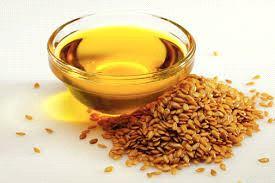
Linseed (Linum usitatissimum L.) belonging to Linaceae is an annual dicotylednous crop. Linseed oil is obtained by pressing, sometimes followed by solvent extraction. Linseed oil is a drying oil, meaning it can polymerize into a solid form. Due to its polymer forming properties, linseed oil is used on its own or blended with other oils, resins, and solvents as an impregnator and varnish in wood finishing, as a pigment binder in oil paints, as a plasticizer and hardener in putty, and in the manufacture of linoleum [1]
Linseed oil is a common carrier used in oil paint. It can also be used as a painting medium, making oil paints more fluid, transparent and glossy. Traditional glazing putty, consisting of a paste of chalk powder and linseed oil, is a sealant for glass windows that hardens within a few weeks of application and can then be painted over. The utility of putty is owed to the drying properties of linseed oil.
Biodiesel is prepared by the Transesterification process. Trans esterification (also called alcoholises) is the reaction of a fat or oil with an alcohol to form esters and glycerol. This reaction requires heat and a strong catalyst to achieve complete conversion of oil into the separated esters and glycerin [2]. A catalyst potassium hydroxide (KOH) is usually used to improve the reaction rate and yield [3]. Because the reaction is reversible, excess alcohol is used to shift the equilibrium to the products side.
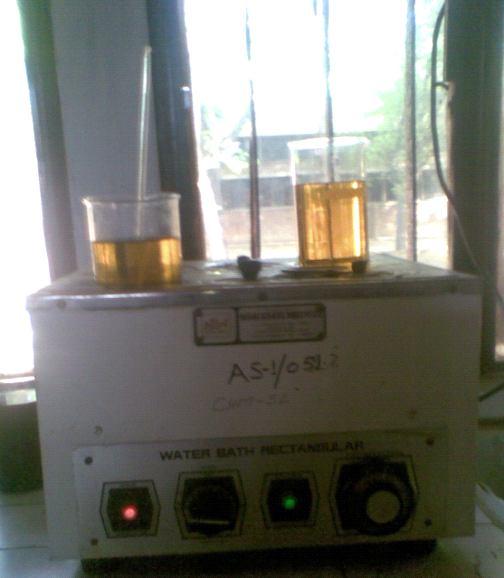


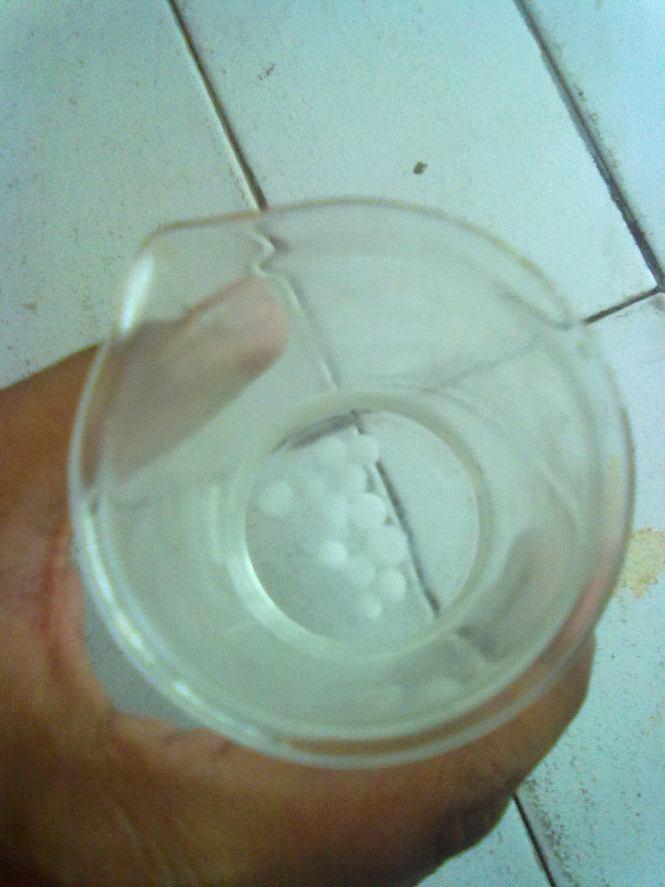
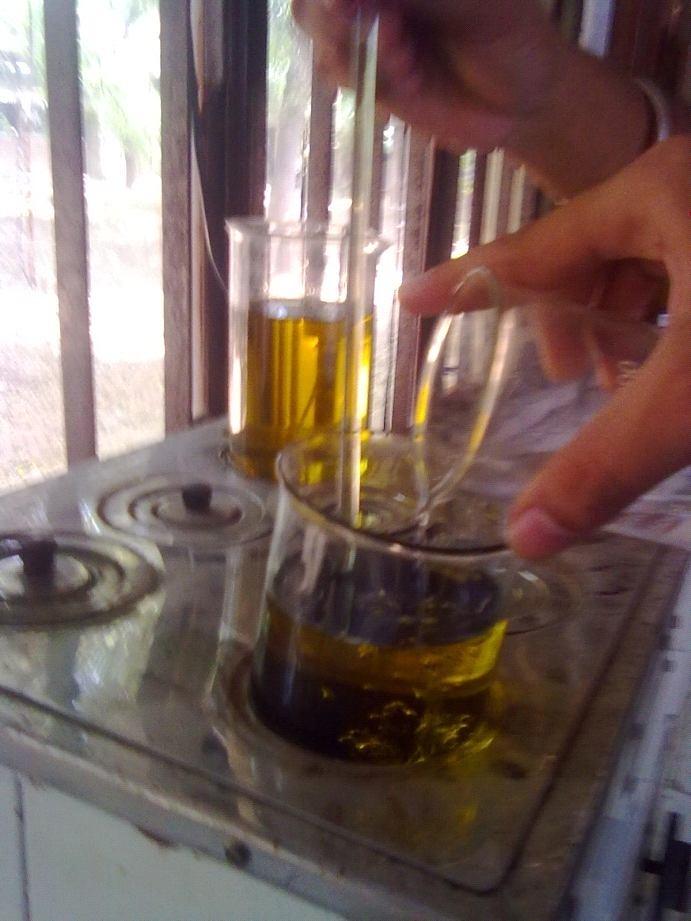
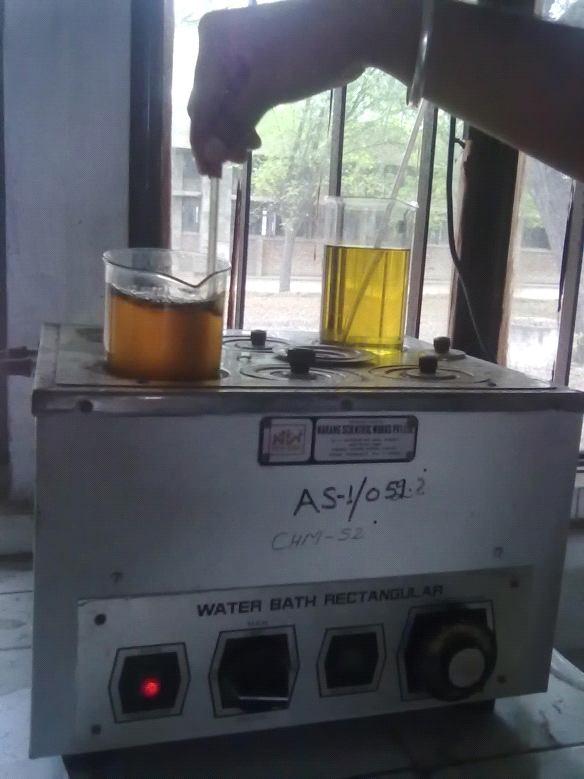
for
Science & Engineering Technology (IJRASET

ISSN: 2321 9653; IC Value: 45.98; SJ Impact Factor: 7.538 Volume 10 Issue VIII Aug 2022 Available at www.ijraset.com
5) Step 5: After this the stirred sample was taken out and was poured in a separating container to separate the glycerol from the methyl ester.
Figure 8: Pouring of mixture in separate container after stirring at constant temperature
6) Step 6: After 24 hours the glycerol was removed and separated to obtain the methyl ester.
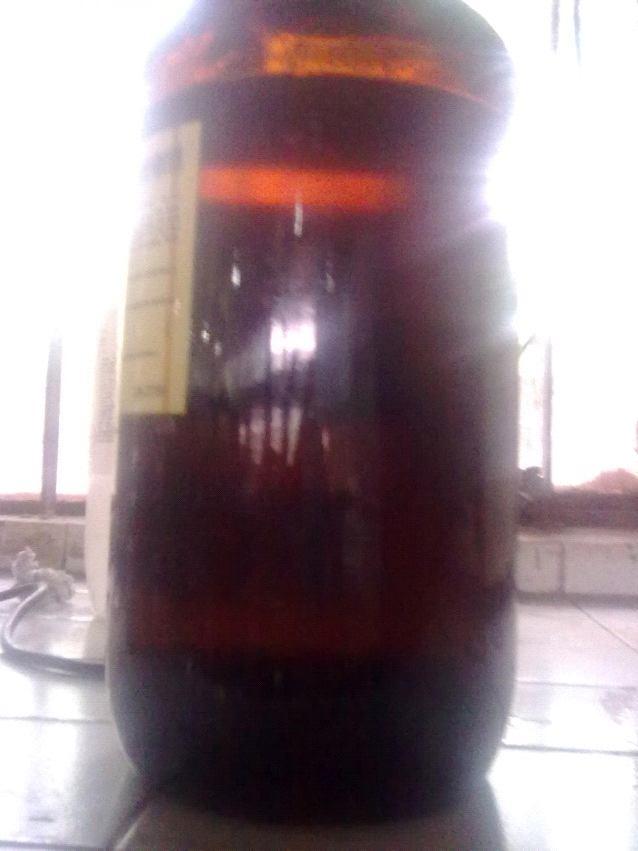
Figure 9: Separations of biodiesel and glycerol [4]
Separation of biodiesel and glycerol takes place by gravity. The black part is glycerol in the separation container as shown in the Figure 10. Settling is carried out in the decanter for 24 Hrs and the settled glycerol will be drained out.
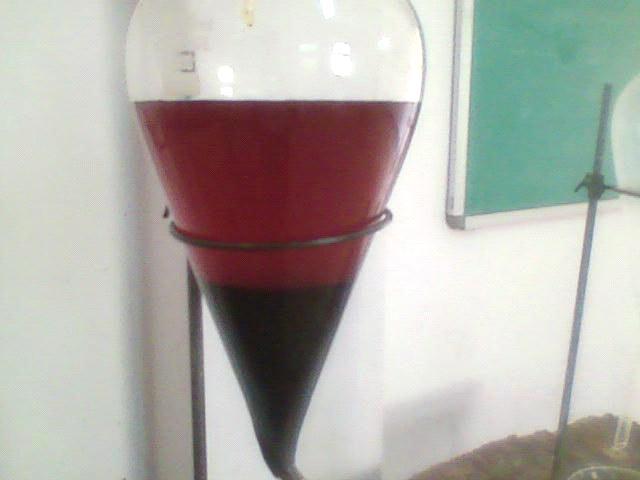
Figure 10: After 24 hours the glycerol sets down and methyl ester stay above
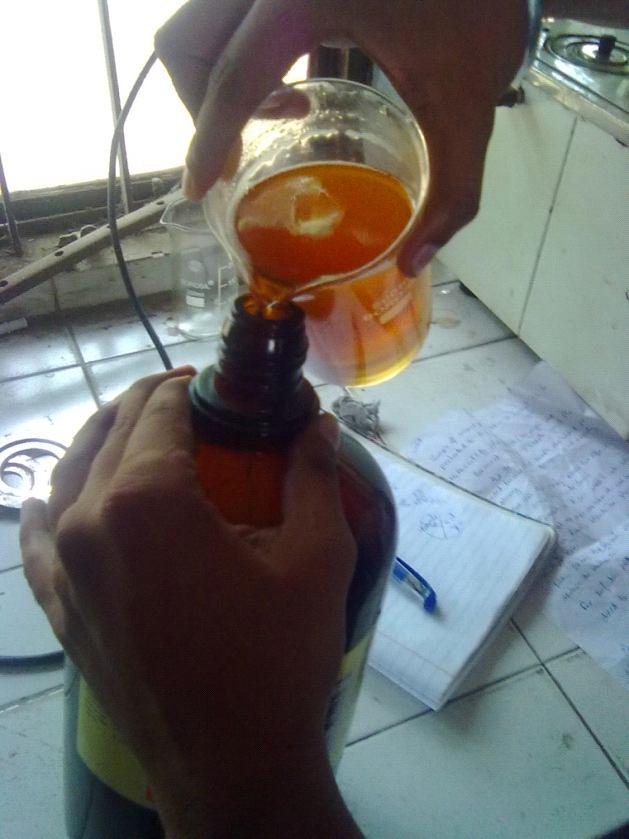
After the transestarification of Linseed oil, the ester of oil and glycerol of transestarified oil is left below. The methyl ester of Linseed oil is separated by sucking it from beaker to a bottle with help of pipe. Then the blends of diesel and Linseed oil are prepared. We made four blends B15, B30, B45 and B60 of 1.25 litres each.
B15 means 15% Linseed biodiesel and 85% diesel
B30 means 30% Linseed biodiesel and 70% diesel
B45 means 45% Linseed biodiesel and 55% diesel
B60 means 60% Linseed biodiesel and 40% diesel
Factor
Factor
2321
IC Value: 45.98; SJ Impact Factor:

10 Issue VIII Aug 2022 Available at www.ijraset.com
Figure 11: Blending of Linseed Oil with diesel with help of keep and measuring cup
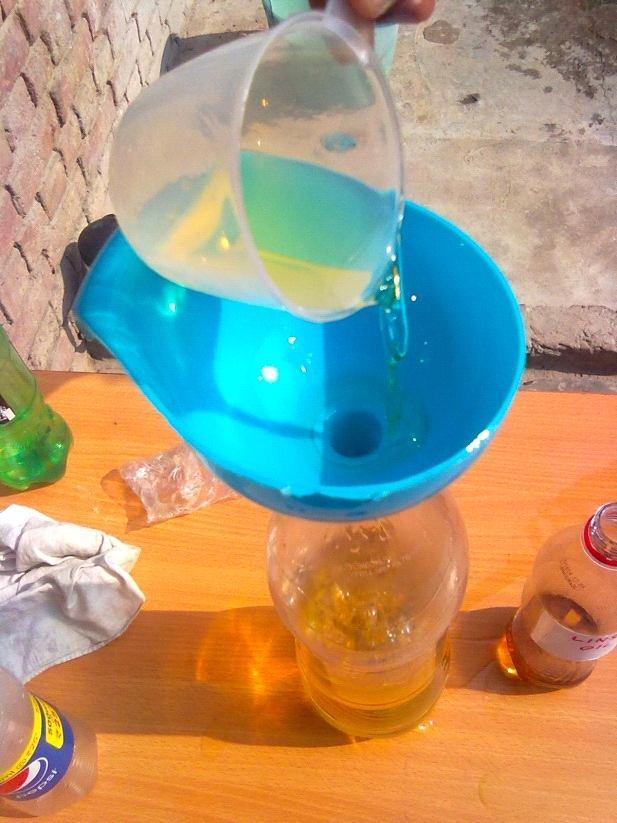
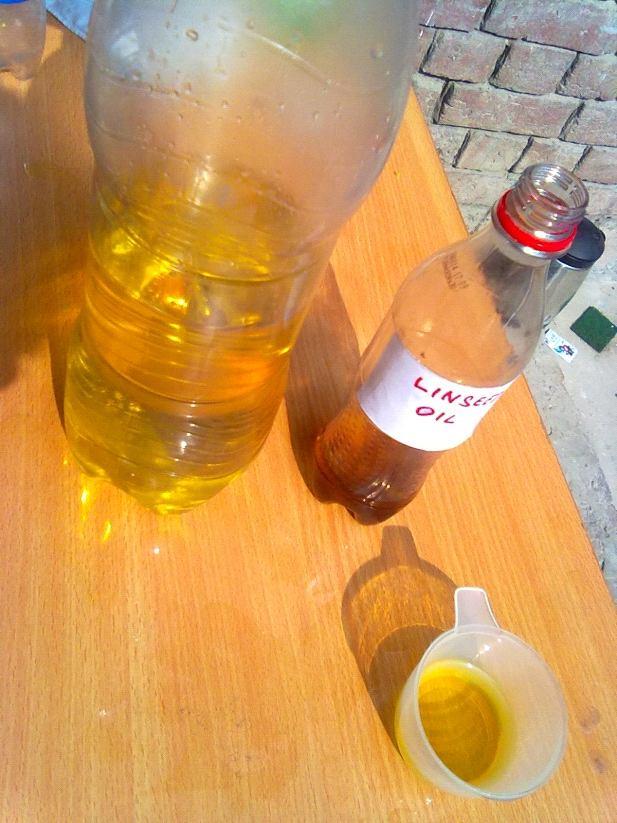
After preparation of various blends of biodiesel it is tested in engine to check the performance of engine. The Four Stroke Vertical single cylinder diesel engine was used for experimentation. The filter of the diesel engine was disconnected from its diesel tank and connected directly to fuel measuring unit [5] The Diesel Engine is coupled to a Hydraulic dynamometer that acts as a loading device. The reaction torque of the dynamometer measured either using a spring balance and dead weight or a load cell. The engine and hydraulic dynamometer are directly coupled on a substantial base plate. The Engine has the following specifications
Table 1: Technical Specifications Make Greaves Model1510
Engine Type Four Stroke, Single Cylinder, Vertical Bore 85mm Stroke 90mm Displacement 510cc RPM 3000 BHP 10 Compression Ratio 17.5:1 Mode of Injection Compression ignition
Cooling System Air Cooled Dynamometer Hydraulic Dynamometer
Brake specific fuel consumption (BSFC) is the ratio between mass fuel consumption and brake effective power, the loss of heating value of biodiesel must be compensated with higher fuel consumption. Fig. 12. compares the BSFC of pure diesel and its blends with Linseed oil biodiesel fuel. There was about higher specific fuel consumption when running on B15, B30, B45 and B60 than diesel fuel.
Table 2: BSFC of Blended Linseed oil in Kg/Kw.h
B15 B30 B45 B60 B0
0.291024 0.330507 0.321051 0.324690 0.3608
0.222366 0.217783 0.235178 0.2408
0.168894 0.166247 0.181992 0.1822
2321
10 Issue VIII Aug
Specific Fuel Consumption (Kg/Kw.h)
Figure
Factor:
(Kg)
The variation of brake thermal efficiency with speed for different blends is presented in fig. 13. The brake thermal efficiencies were obtained to be 44% for B15, which was higher than that of all blends.
Table 3: Brake Thermal Efficiency of Blended Linseed oil Load B15
10 0.210027 0.184313 0.18432 0.18149 0.17 15 0.303990 0.27394 0.27172 0.25057 0.2537 20 0.387 0.36067 0.356126 0.3238 0.335

Figure
Variations of Brake thermal efficiency vs Load of Linseed oil blends with Diesel
Journal for Research in Applied Science & Engineering Technology (IJRASET)

ISSN: 2321 9653; IC Value: 45.98; SJ Impact Factor: 7.538
Volume 10 Issue VIII Aug 2022 Available at www.ijraset.com
In the current investigation, it has confirmed that Linseed oil may be used as resource to obtain the bio diesel. The methyl esters of Linseed along with diesel may reduce the environmental impacts of transportation and also reduce the dependency on crude oil imports, and also provide employments in agricultural field. The conclusions are summarized as follows.
1) There was increase in Brake Thermal Efficiency of B15 as compared to Pure Diesel because of complete combustion.
2) Brake Specific Fuel Consumption has not much affected by the blending of oil with the diesel fuel.
From the study of Linseed oil, it has been found that the performance of biodiesel, mixture of 15% biodiesel & 85% diesel (B15) and compared with diesel and found that the brake power, brake thermal efficiency is greater than diesel. Linseed oil has potential as an alternative energy source. However, this oil alone will not solve our dependence on foreign oil within any practical time frame. Use of this and other alternative energy sources could contribute to a more stable supply of energy. From the study of Linseed oil it has been found that the BSFC of B15 biodiesel blend was found to be higher than diesel fuel. As the proportion of biodiesel blend increased, the BSFC was observed to be increased. This is due to the higher density of biodiesel As the percentage of blend increases the density also increases. Also, brake thermal efficiency is found to decrease with the increase in blend content B15, B30, B45 and B60. This is due to the higher viscosity of blends which led to the poorer atomization and poor combustion.
[1] Faizan Ullah et. Al. “Optimization of protocol for biodiesel production of linseed (Linum usitatissimum L.) oil” TePcohl.i,s hV oJol.u 1rn5,a lN oof. C1,h e2m01ic3al Technology, 15, 1, 74 77, 10.2478/pjct 2013
[2] Jawalkar A. et. Al. “Performance and Emission Characteristics of Mahua and Linseed Biodiesel Operated at Varying Injection Pressures on CI Engine” International Journal of Modern.
[3] Tahvildari K. et. al., “Synthesis of Ethyl Ester (Biodiesel) From Linseed Oil, Using Transesterification Double Step Process (TDSP)” Academic Research International Vol. 5(2) March 2014 Copyright © 2014 SAVAP International
[4] Lingaraju D. et. Al. “Fuelling diesel engine with diesel, linseed derived biodiesel and its blends at different injection pressures: performance studies” International Journal of Management, IT and Engineering (2012)
[5] Dwivedi Gaurav et al., “Performance Evaluation of Diesel Engine Using Biodiesel from Pongamia Oil” International Journal Of Renewable Energy Research Vol.3, No.2, 2013
[6] Russo D. et. al., State of the art of biofuels from Pure Plant Oil, RSER 1812 27 02 2012
[7] Engineering Research (IJMER), 2, Page 1142 1149, 2012
[8] Sonntag NOV. “Structure and composition of fats and oils” In: Swern D, editor 4th edition. Bailey’s industrial oil and fat products, vol. 1, 4th edition. New York: John Wiley and Sons; 1979.
[9] Planning Commission India, Report of the committee on development of bio fuel, 2003.
[10] Demirbas Ayhan “Progress and recent trends in biodiesel fuels” Energy Conversion and Management, 50, Page 14 34, 2009
[11] National Council of Applied Economic Research (NCAER) & The Solvent Extractors “Overview of Indian Oilseed Sector Outlook for India’s Edible Oil Sector,Issues & Challenges” 15th March 2013, Delhi.
[12] Prakash C.B. “A critical review of biodiesel as a transportation fuel in Canada”. A technical report. Canada: GCSI Global Change Strategies International, Inc., Transportation Systems Branch; March 25, 1998
[13] Ciolkosz Daniel et. al., Penn State Biomass Energy Center and Department of Agricultural and Biological Engineering 2013
[14] Romano S. D. et. al., Dielectric Spectroscopy in Biodiesel Production and Characterization, Green Energy and Technology, DOI: 10.1007/978 1 84996 519 4_2, _ Springer Verlag London Limited 2011
[15] Shah A. N. et. al., Effect of Biodiesel on the Performance and Combustion Parameters of a Turbocharged Compression Ignition Engine, Pak. J. Engg. & Appl. Sci. Vol. 4, Jan 2009 (p. 34 42)
Factor
